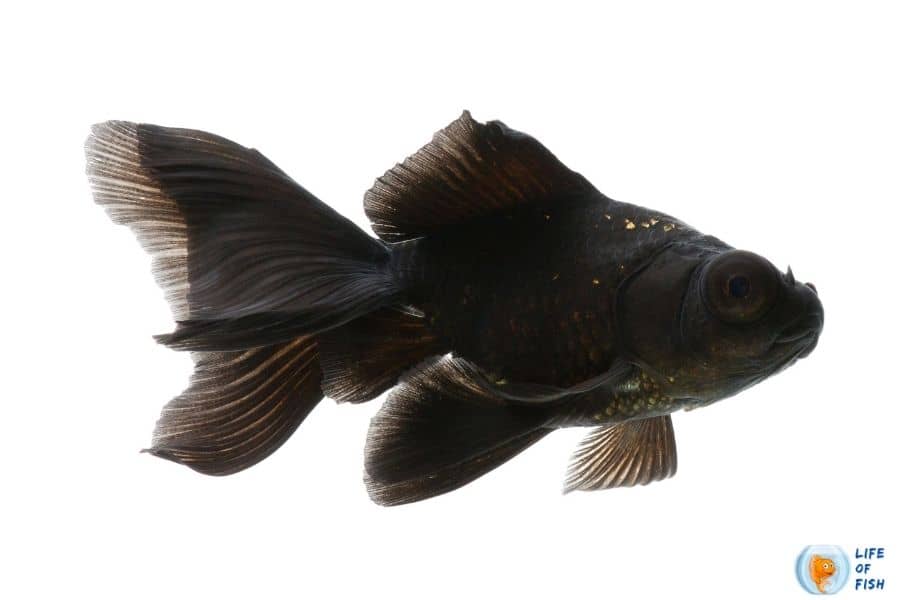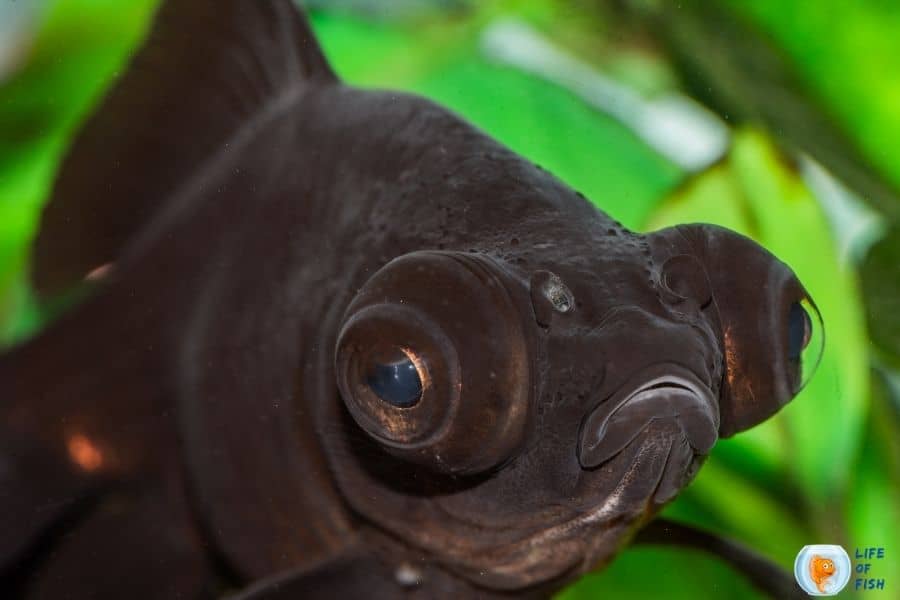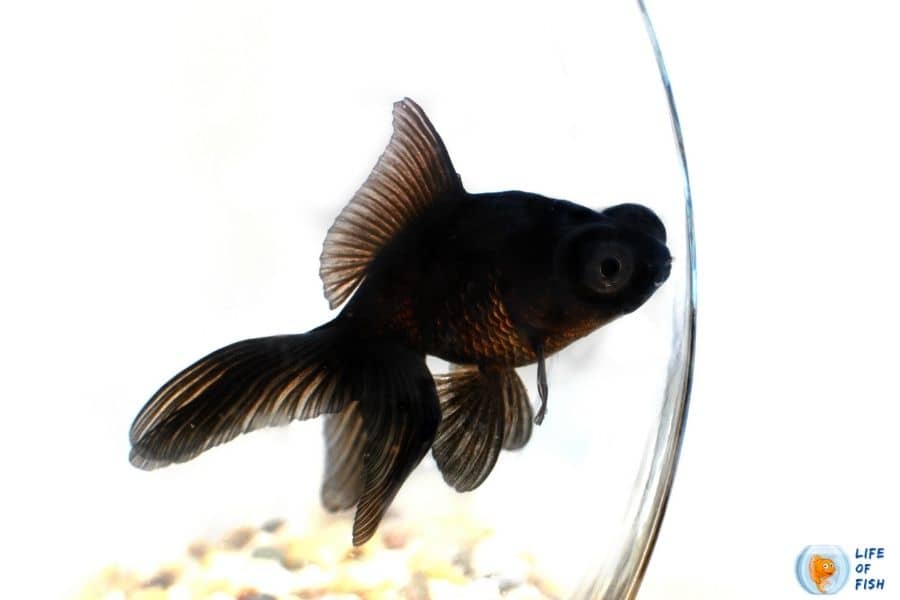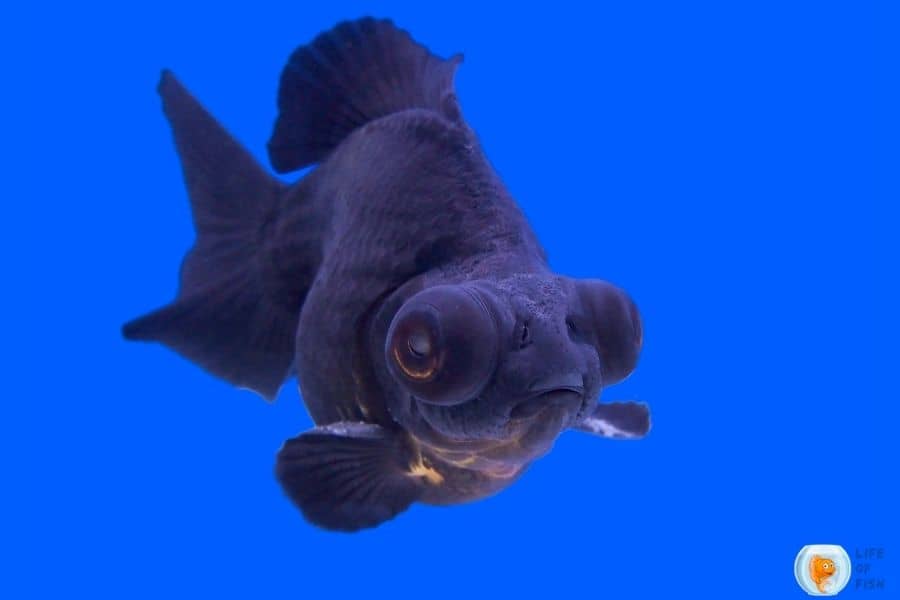Everybody knows that goldfish are one of the easiest breeds to care for in an aquarium. So, why do we write specifically about black moor goldfish? Because they need special care than other goldfish breeds.
They are more delicate, hence are more susceptible to diseases. Therefore, you need to know more things to keep these goldfish in your aquarium.
This is a comprehensive guide on how to take care of black moor goldfish in an aquarium.

What is Black Moor Goldfish?
Jump To
- 1 What is Black Moor Goldfish?
- 2 How big do Black Moor Goldfish get?
- 3 Black moor goldfish appearance
- 4 Black Moor Goldfish lifespan
- 5 Is Black Moor Goldfish aggressive?
- 6 Black Moor Goldfish behavior
- 7 One Look Care guide
- 8 Black Moor Goldfish care
- 9 Black Moor Goldfish breeding
- 10 Special tips
- 11 How to feed Black Moor Goldfish?
- 12 What fish can live with Black Moor Goldfish?
- 13 Black moor goldfish issues and diseases
- 14 Related questions
- 15 Conclusion
They are a variety of goldfish (Carassius auratus) that has a velvety black coat.
They are also called Telescope Goldfish because of their protruding eyes. These fish are bred for their long-flowing fins and unique coloration.
Unlike the common goldfish, you can not find this goldfish variety in the wild because it is a captive-bred one.
Black moor goldfish were designed crossbreeding red telescope goldfish and a Veiltail goldfish or a fancy Fringetail goldfish.
They are among the most popular goldfish varieties because of its elegant appearance.
However, they are not suitable as beginner-friendly fish because they are more delicate than other goldfish breeds.
How big do Black Moor Goldfish get?
The average size of a them is about 3-4 inches. However, they can grow up to 8 inches in length, depending on their diet and environment.
Black moor goldfish appearance
As the name suggests, they are black in color. However, it is not surprising to see a reddish-gold sheen on the scales and the underside of their body. This is because these fish are crossbred from different types of goldfish.
The most prominent features of them are their protruding eyes and long flowing fins. They also have a round body shape with a deep caudal peduncle.
There are mainly two black moor goldfish varieties.
- Veiltail – this variety has long, trailing fins with a shorter and rounder body to compensate with their tails.
- Fringetail – this variety has a comparingly shorter tail (still longer than other types of goldfish) with a thinner body. The tail is v-shaped and has more fringe than the Veil Tail.
The gold sheen usually appears more when the fish gets older, which is not something to worry about.
Black Moor Goldfish lifespan
They can live for about 10-15 years when properly cared for. In rare cases, these fish can even live up to 20 years.
Is Black Moor Goldfish aggressive?
Compared to common goldfish, black moor goldfish are more peaceful and friendly than other goldfish species.
They usually get along well with other goldfish and other fish breeds. However, you should gradually introduce them to the tank mates to avoid any conflicts.
Black Moor Goldfish behavior
They are more docile than other goldfish. Although these fish are peaceful and friendly, they are easily scared.
When they are scared, they tend to hide in the corners of the tank or under the decorations.
They are not active swimmers like the common goldfish. They are slow and spend most of their time in the middle of the tank.
Because of their slow-moving nature, these fish often don’t stand a chance to eat enough food with other fast-moving tank mates.
Therefore, you need to feed them a lot of food to ensure they get enough nutrients. One efficient trick is to use an automatic fish feeder to dispense food at scheduled times.
They will get along well with other fancy goldfish types that are slow and docile like them but will not do well with single-tailed breeds as they are fast and aggressive.
One Look Care guide
| Scientific name | Carassius auratus |
| Common name | Black moor goldfish |
| Care level | Moderate |
| Native to | China (Captive bred) |
| Type | Freshwater fish |
| Color | Black |
| Tank size | 20 gallons minimum |
| Preferred temperature | 65-75 degrees Fahrenheit |
| Water parameters | pH level – 7 to 8 Hardness – 10 to 20 dGH |
| Preferred salinity | No salinity |
| Size | 8 inches |
| Life Span | 10 to 15 years |
| Temperament | Peaceful |
| Recommended tank mates | Peaceful fish |
| Preferred food | Omnivorous, pellets, flakes, live and frozen food, vegetables, fruits |
| Feeding frequency | Two times per day |
| Breeding | Egg layers, easy |
Black Moor Goldfish care
When caring for these fish, you should keep in mind that these fish are more fragile than other goldfish breeds. Their telescopic eyes and long-flared fins often make them susceptible to injuries.
You need to observe your tank and remove any sharp objects in the tank that can cause injury and You should also avoid overfeeding them as it can cause health problems.
Then you must be extra careful when choosing tankmates for black moor goldfish. You should avoid putting them with any fast and aggressive fish breeds as they can easily injure the black moor goldfish.
Black Moor Goldfish size
They are one of the smaller goldfish breeds. They typically grow 3-4 inches in length. However, they can reach up to 8 inches in size, depending on their diet and environment.
Black Moor Goldfish tank size
A 20-gallon is a minimum tank size for a goldfish. However, because these fish are fragile, you should consider 30 gallons or larger tank. This will give your goldfish plenty of space to swim and grow safely.
How many Black Moor Goldfish should be kept together?
You can keep as many black moor goldfish as you like in your tank, given that you have a large enough tank.
However, you can keep only one black moor goldfish in a 20-gallon tank. If you want to keep more, you should keep no more than one of them per additional 10 gallons of water.
This will help ensure that they have enough space to swim and grow. You can keep more than one black moor goldfish if you have a bigger tank.
Tank setup
Since these are goldfish, black moor goldfish also prefer the same tank setups as other goldfish breeds.
You should provide them with a tank with plenty of plants and decorations to swim around.
You should also provide them with a substrate that they can graze on. A good choice for a substrate is gravel, as it will help keep the tank clean.
When choosing decorations, substrate, and equipment, be careful to choose ones with no sharp edges as they can easily injure the fish.
You should also avoid using metal decorations as they can rust and release harmful toxins into the water.
Filtration and other equipment
You should provide your black moor goldfish with an efficient filtration system to keep the water clean and healthy. You should change 25-30% of the water in the tank every week.
These fish can survive in extreme water conditions, but for the sake of their well-being, we recommend adding an air pump to the tank to create water movement. This will help keep the water healthy and oxygenated.
Lighting
They prefer to stay in the shade, but they require moderate lighting in their surroundings. You can provide them with a tank with either an overhead light or a window to allow natural sunlight.
Heater
They do not require a heater as they can live in water temperatures that range from 65-75 degrees Fahrenheit.
However, if you keep your tank at a lower temperature, you will need to provide a heater to keep the water warm.
Tank lid
Asthey are slow swimmers, they don’t try to jump out of the tank. Still, if you have other fish species in the tank, you should install a lid to prevent them from jumping out.
When choosing a tank for your black moor goldfish, make sure to get one that is at least 30 gallons in size. This will give your goldfish plenty of space to thrive.
Water quality condition
They do best in pristine water conditions. You should test the water quality regularly and make sure to keep the levels of ammonia, nitrite, and nitrate low.
Now, you can do this by frequently changing the water in the tank and using an efficient filtration system.
You should also avoid overfeeding your fish, which can lead to water quality problems. A good rule of thumb is only to feed them what they can eat in 2 minutes or less.
The best water temperature for black moor goldfish is 65-75 degrees Fahrenheit. They do best in neutral to slightly alkaline water. The preferred pH level is 7 to 8, and the preferred water hardness is 10 to 20 dGH.

Black Moor Goldfish breeding
Breeding of them are relatively easy. You will have to isolate a pair in a breeding tank and condition them in their spawning season.
The spawning season of goldfish arrives when the water temperature reaches 68 degrees Fahrenheit. This usually happens in the Spring.
Black Moor Goldfish male or female identification
Unlike the common goldfish, sexing black moor goldfish is hard because they have no external sexual differences.
However, the male black moor goldfish has a more pointed and streamlined dorsal fin than the female. The male is also usually smaller than the female.
You can also determine the sex of a black moor goldfish by looking at their reproductive organs. The male’s organs are more pronounced, and the female’s organs are less noticeable.
Further, when the spawning season begins, the male goldfish develops small bumps known as “breeding tubercles.” You can find them on the gill covers, the head, and the pectoral fins.
Identify pregnant Black Moor Goldfish and thier pregnancy stages
They are fatty and rounder from nature. So, it is usually challenging to determine whether a black moor goldfish is pregnant or not.
The easiest way to identify if a black moor goldfish is pregnant is to look for their behavior changes.
When they are pregnant, she will become more aggressive and protective of her territory. She will also start to hide more and not come out to eat as much.
The size of their belly can determine the black moor goldfish’s pregnancy. The pregnant black moor goldfish will have a noticeably round belly than the non-pregnant black moor goldfish.
Black Moor Goldfish breeding
Although goldfishes spawn in the Spring, you can induce spawning anytime by slowly decreasing temperature for about two weeks and then increasing the water temperature by two degrees every day for about four days.
Spawning usually occurs in the early morning. The male will chase the female and nip at her body. The eggs will be released and fertilized as they are expelled.
The eggs will then become attached to plants or other objects in the tank. The parents will usually eat the eggs, but you can remove them to a hatching tank.
The eggs will hatch in about four to seven days. The fry will be free swimming in another four to seven days.
How many babies do Black Moor Goldfish have?
Goldfish can lay a ridiculously large amount of eggs, sometimes up to 10,000 eggs at once.
However, because of the high mortality rate of fry, not many survive. On average, about 20-50% of the fry will make it to adulthood.
So, if you are lucky, you might get a few thousand fries out of a spawning. But, typically, you will get closer to 500 or so.
Black Moor Goldfish fry care
Since they lay thousands of eggs at a time, you will have to provide a large tank to accommodate all the fry.
The fry tank should have a fine gravel bottom and lots of plants. The water should be kept clean and well-oxygenated.
You can feed your fries a variety of foods, including baby brine shrimp, crushed flake food, and powdered food.
You should keep your fries in the fry tank until they are about two inches long. After that, you can transfer them to a community tank.
Special tips
Here are a few special tips for taking care of black moor goldfish:
- Because they are susceptible to Ich, keeping the tank clean and well-oxygenated is important.
- Black moor goldfish are not good tank mates for other goldfish species because they will not be able to compete for food.
- It is important to provide a lot of plants for black moor goldfish to hide in. This will help reduce stress and make them feel more comfortable.
- Black moor goldfish are prone to diseases, so it is essential to feed them a balanced diet and not overfeed them.
- If you have a pregnant black moor goldfish, it is essential to provide a lot of places for her to hide. This will help reduce stress and protect her from other fish.

How to feed Black Moor Goldfish?
As these fish are omnivorous, they love to eat live, fresh, and frozen food. You should offer them a wide variety of food to ensure they get the nutrients they need.
Some good food options for black moor goldfish include:
- Live brine shrimp
- Frozen bloodworms
- Freeze-dried tubifex worms
- Crushed flake food
- Pellets
- Vegetables ( blanched and chopped)
- Algae wafers
- Daphnia
It is important not to overfeed your goldfish. This can lead to health problems and a messy tank.
A good rule of thumb is only to feed them what they can eat in two minutes or less. You have to remove any uneaten food from the tank.
Generally, two feedings per day should be enough. However, black moor goldfish can be fed more or less, depending on their individual needs.
For example, if you want to breed your goldfish, you should provide more with a protein-based diet. If the fish is bloated, feeding less is essential.
What fish can live with Black Moor Goldfish?
As black moor goldfish are peaceful and friendly fish, you should be able to keep them with most other fish. However, it is necessary to do your research first to ensure they will get along.
Due to their long fins, you should avoid adding any fin nipping fish to the tank. Also, avoid adding larger fish than your black moor goldfish as they may bully them.
Never house any aggressive or semi-aggressive fish because these fish can not compete with them.
Black moor goldfish are slow swimming fish, and they have a delicate body shape that is prone to injuries. Any injury that happens to their eye can cause blindness.
Some good tank mates for black moor goldfish include:
- Other types of goldfish
- White cloud mountain minnows
- Danios
- Rasboras
- Platies
- Swordtails
- Gouramis
- Guppies
- Mollies
- Tetras
- Cory catfish
- Barbs
When adding new fish to the tank, it is vital to add them slowly over a period of two or three days. This will help avoid any potential aggression and stress.
If you are not sure whether or not a certain fish can live with black moor goldfish, ask your local pet store for advice. They should be able to help you find the perfect tank mates for your fish.

Black moor goldfish issues and diseases
As we said before, there are issues and diseases that black moor goldfish are prone to. This is why it is important to be aware of these and take the necessary precautions.
Some common diseases and issues that black moor goldfish can suffer from include:
Ich
Since black moor goldfish have a compressed body, they are more prone to Ich than other goldfish species. This protozoan parasite can cause skin lesions and affect the gills.
Treatment: There are various treatments for Ich, including salt baths and medications.
Prevention: You can take several steps to prevent Ich, including keeping the water temperature cool, keeping the tank clean, quarantining new fish and decorations, and not overcrowding the tank.
Fin rot and tail rot
This is a bacterial infection that affects the fins and tail of goldfish. Poor water quality or stress can both contribute to it.
Treatment: Fin rot can be treated with antibiotics, but getting the diagnosis first is essential.
Prevention: To help prevent fin rot, make sure to keep the water quality in your tank good and not overfeed your fish. Further, quarantine any new fish for at least one month before introducing them into your tank.
Anchor worm
This is a parasitic worm that attaches itself to a fish’s skin. It can cause inflammation and skin lesions.
Treatment: Anchor worms can be treated with various medications.
Prevention: To prevent anchor worms, keep the tank clean and quarantine any fish before introducing them to your aquarium. Further, avoid feeding your fish wild-caught live food.
Dropsy
Dropsy is a condition where the fish’s body swells up with fluid. It can be caused by many different things, including bacterial infection, parasites, and toxins.
Treatment: There is no cure for dropsy, and the fish will usually die.
Prevention: There are a few things you can do to help prevent dropsy, including keeping the tank clean, quarantining new fish, and not overfeeding your fish.
Eye infections
This is a common infection caused by many different things, including bacteria, fungus, or parasites.
Treatment: Eye infections can be treated with antibiotics or anti-fungal medications.
Prevention: To prevent eye infections, keep the tank clean, avoid adding incompatible fish, avoid sharp objects in the tank and keep the water temperature cool.
Worms
Many different types of worms can affect fish, including nematodes, flukes, and tapeworms.
Treatment: Worms can be treated with various medications.
Prevention: There are a few things you can do to help prevent worms, including keeping the tank clean, avoiding wild-caught fish food, quarantining new fish, and ensuring that your fish eat a balanced diet.
Fish lice
Fish lice are tiny, parasitic crustaceans that attach themselves to fish skin.
Treatment: Fish lice can be treated with various medications.
Prevention: To prevent fish lice, keep the tank clean and ensure that your fish eat a balanced diet.
Flukes
Flukes are a type of parasitic flatworm that can infect the gills and bloodstream of fish.
Treatment: Flukes can be treated with various medications.
Prevention: There are a few things you can do to help prevent flukes, including keeping the tank clean and ensuring that your fish don’t eat wild-caught fish food like worms, planaria, etc.
Keep an eye on your black moor goldfish, and if you see any of these signs, take them to a vet immediately.
Related questions
Is Black Moor Goldfish rare?
No. Black moor goldfish are common and available to buy at any pet store.
How long does a Black Moor Goldfish live?
A black moor goldfish can live for 10-15 years, depending on the care it receives.
Conclusion
Black moor goldfish are beautiful fish that make a great addition to any aquarium. They are low-maintenance fish and can cohabit well with other fish species.
However, they are susceptible to many diseases, so it is important to be aware of the symptoms and know how to treat them.
You can avoid a lot of these problems by providing a safer environment and compatible tank mates. If properly cared for, these fish can thrive in your aquarium for a very long time.
Read Next : Blue Oranda Goldfish Care Guide |13 Fascinating Facts | Siamese Doll Goldfish Care 12 Things Must Know Calico Goldfish | Care and 15 Things Must Know
